Franklin Falls: Washington’s Famous Frozen Waterfall in Winter
Searching for an outdoor adventure to appreciate the beauty of Washington State during the winter? Look no further than the captivating Franklin Falls hike. Nestled in the heart of the Cascade Mountains, this enchanting winter wonderland boasts a breathtaking waterfall frozen in time. In this blog post, we will guide you on the winter route to Franklin Falls & share some key tips to ensure an unforgettable hiking experience.
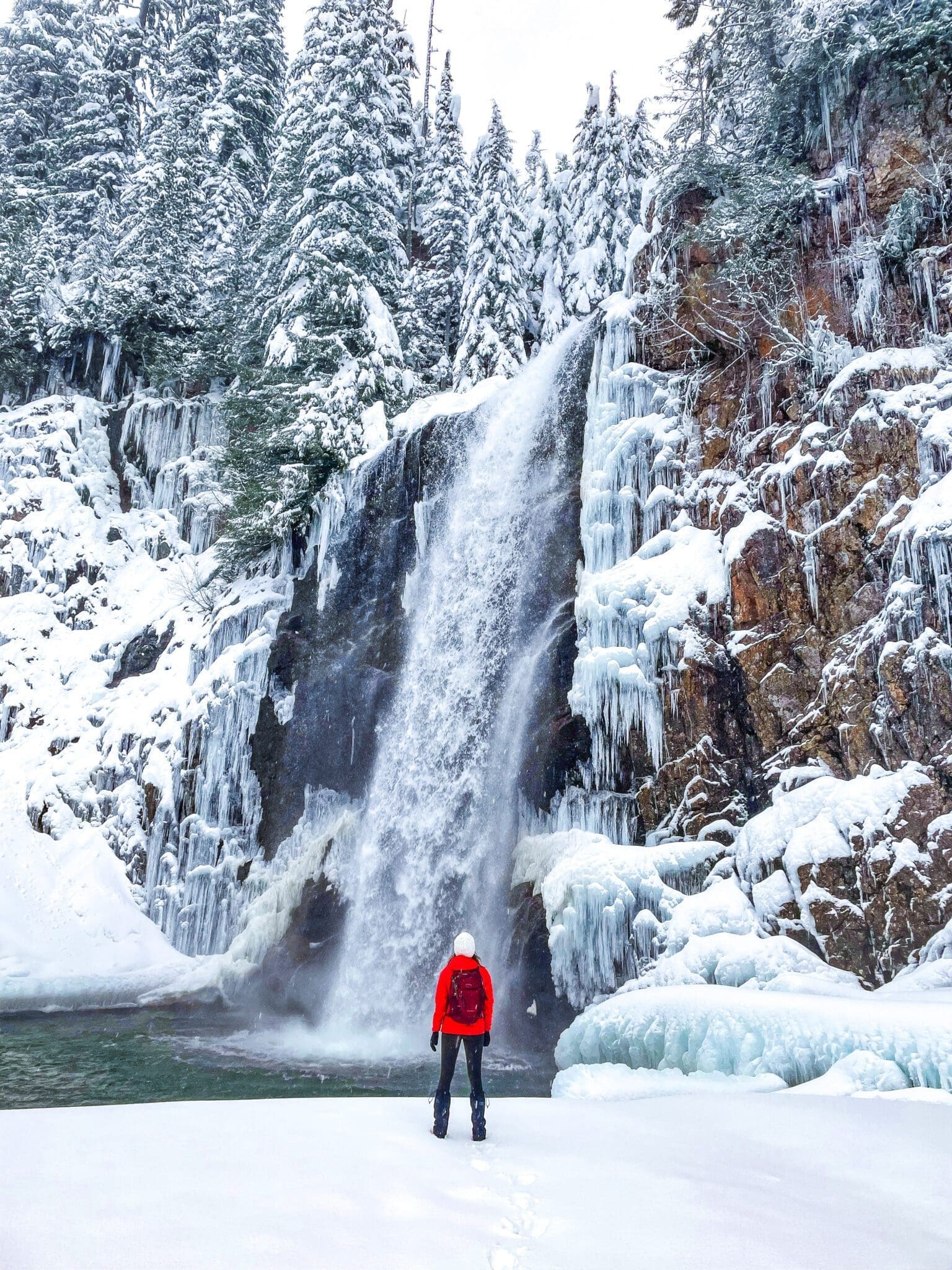
Please note: This post contains affiliate links.
This means that, at no extra cost to you, I may receive a small commission if you make a purchase through my affiliate link.
You may read my full disclosure policy here.
Quick Trail Stats for Franklin Falls (Winter Route)
📈 AllTrails rating: Moderate
🥾 Length: 6.9 miles RT
🏔️ Elevation gain: 816 feet
✅ Sno-Park Permit required in the winter
🐶 Leashed dogs are welcome
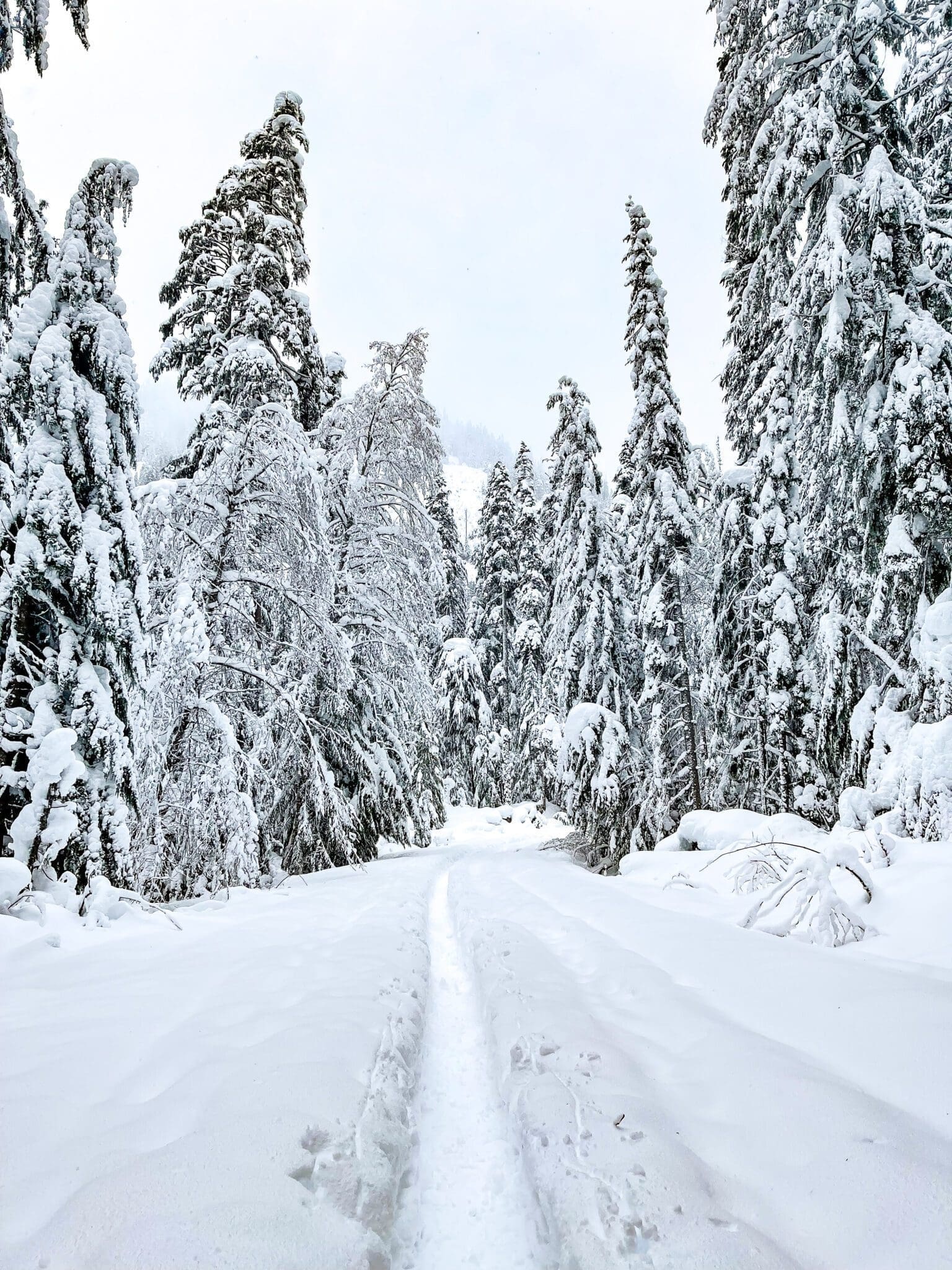
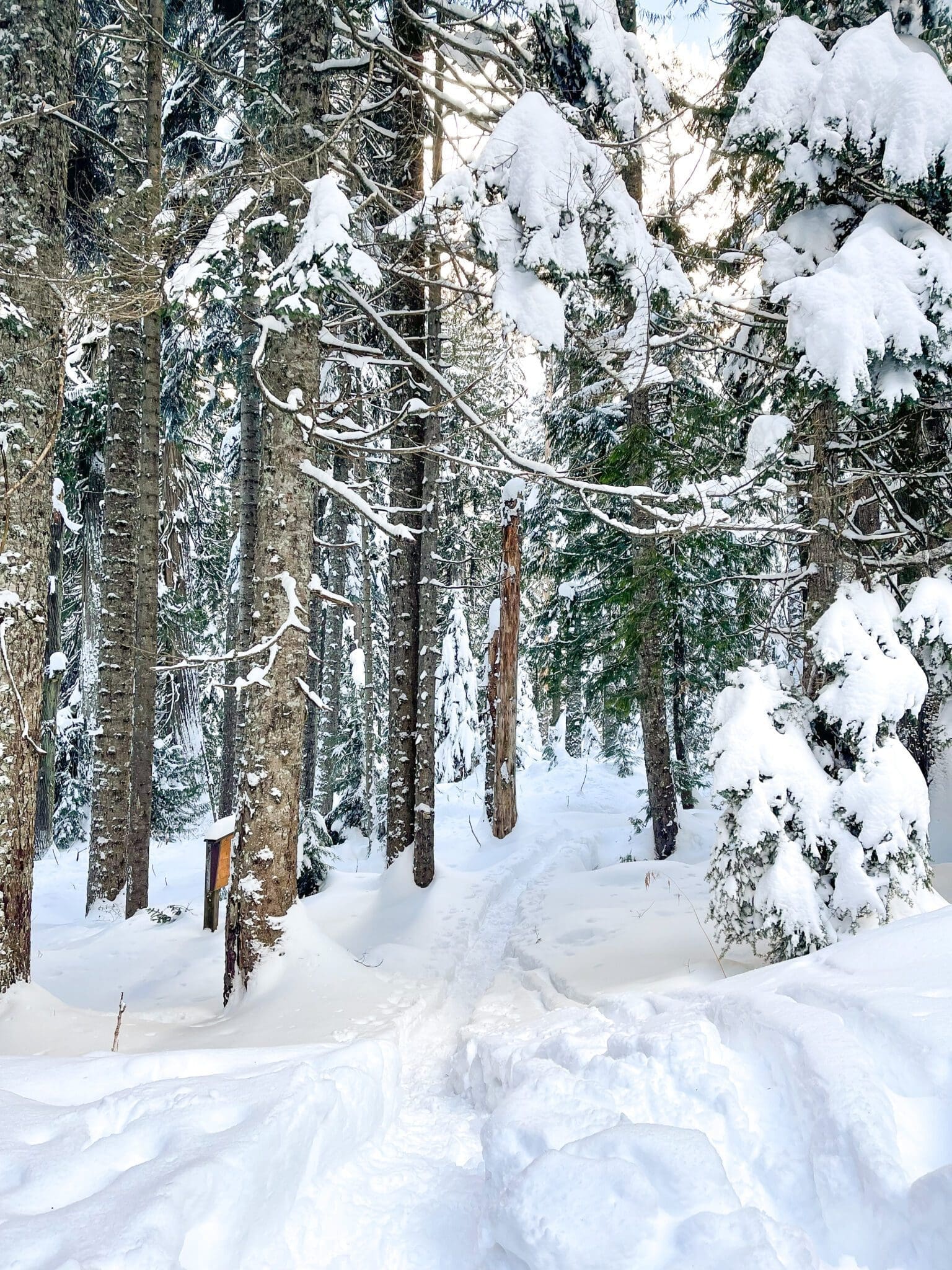
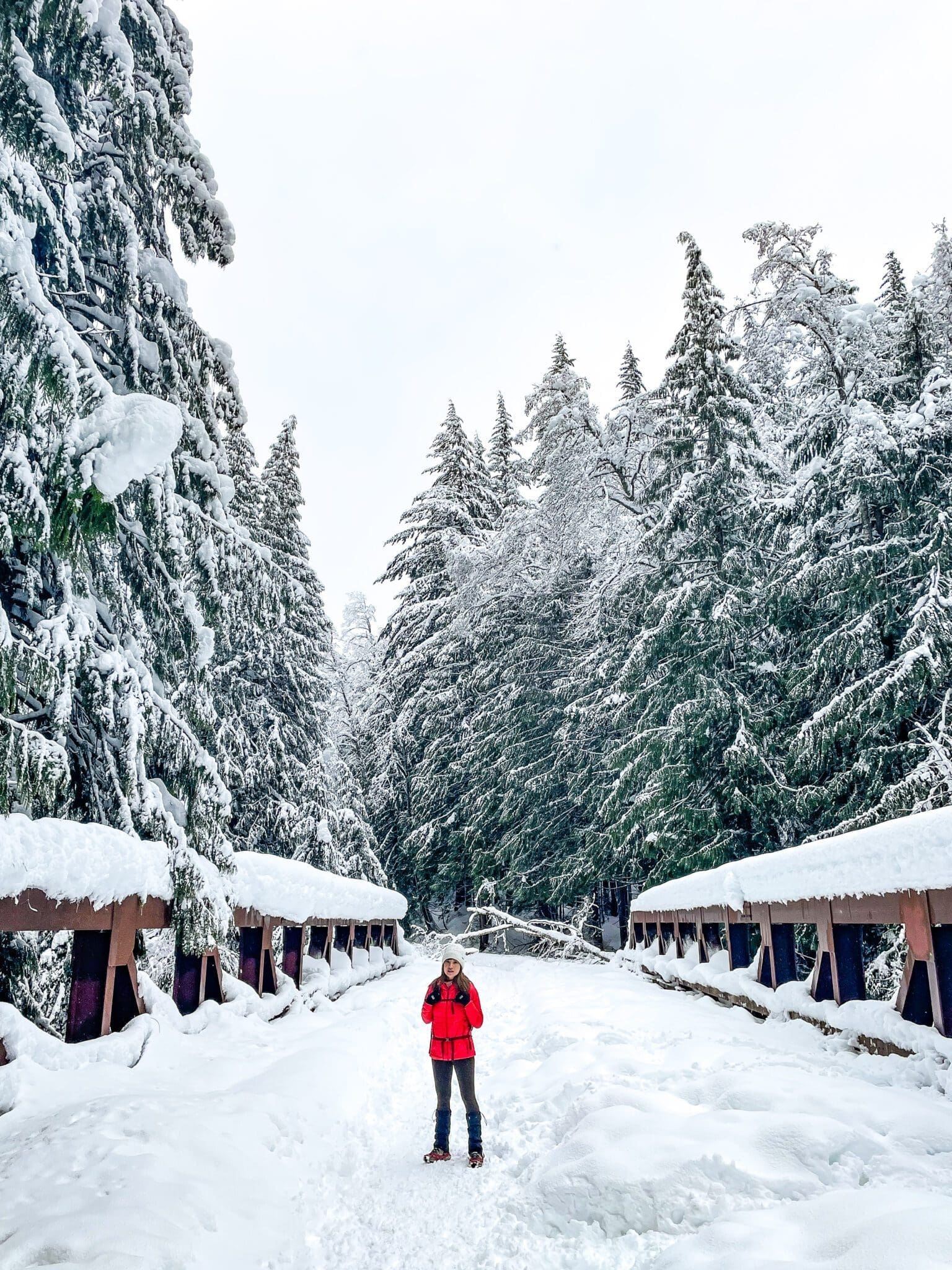
Directions to the Winter Route for Franklin Falls
Franklin Falls is a popular, easy hike that is enjoyed by locals & tourists alike. It is conveniently located near Snoqualmie Pass which is about an hour’s drive from Seattle. Because of its accessibility, you will find hikers here all year round, with summer season being especially busy.
While the main trailhead to Franklin Falls has a large dedicated parking lot, visitors in the winter must park at Asahel Curtis Sno-Park or along Denny Creek Road. This is due to the risk of icy roads with heavy snowfall, making it an easy trap for cars to spin out into ditches. Just take Exit 47 off of I-90 & make a left turn onto NF-55 to pass over the freeway. You may see cars already parked along NF-9034 up to the overpass junction that turns onto NF-58. Use your common sense & best judgement as to how far your vehicle can go.
Starting your trek from this point will add approximately 5 miles round-trip to your hike, so prepare yourself. Fortunately, the road is mostly flat & the snow is densely packed from heavy foot traffic such that you may not need snowshoes. However, I highly recommend bringing along microspikes as the additional traction will be most beneficial through most of your journey through the forest.
How to Find the Instagram Famous Red Cabin
The main trail to Franklin Falls is only a mile long & easy to follow. The first 0.7 miles from the trailhead runs parallel to NF-58 & consists of little to no switchbacks with subtle inclines. As you navigate your way through snow-laden trees, there are many picturesque views overlooking the Snoqualmie River flowing down below.
About 3/4 into the hike, you can find the magical red cabin seen all over social media, tucked away on the left. This is an epic photo opportunity so take advantage of it! Continue back out onto the trail & soon you will hear the roaring sounds of the waterfall in the distance.

After the final 0.3 miles, you will reach the picturesque waterfall on the South Fork of Snoqualmie River. Up above is the overpass for NF-58, which is usually pretty noisy during the summer. Witnessing Franklin Falls flowing powerfully onto the snow-packed boulders below is quite a sight to behold! Hikers can hike up to the base of the waterfall by following a narrow path up against the rocky face to the right. Depending on the weather conditions, it can get really wet & slippery so please use caution if you choose to venture down further.
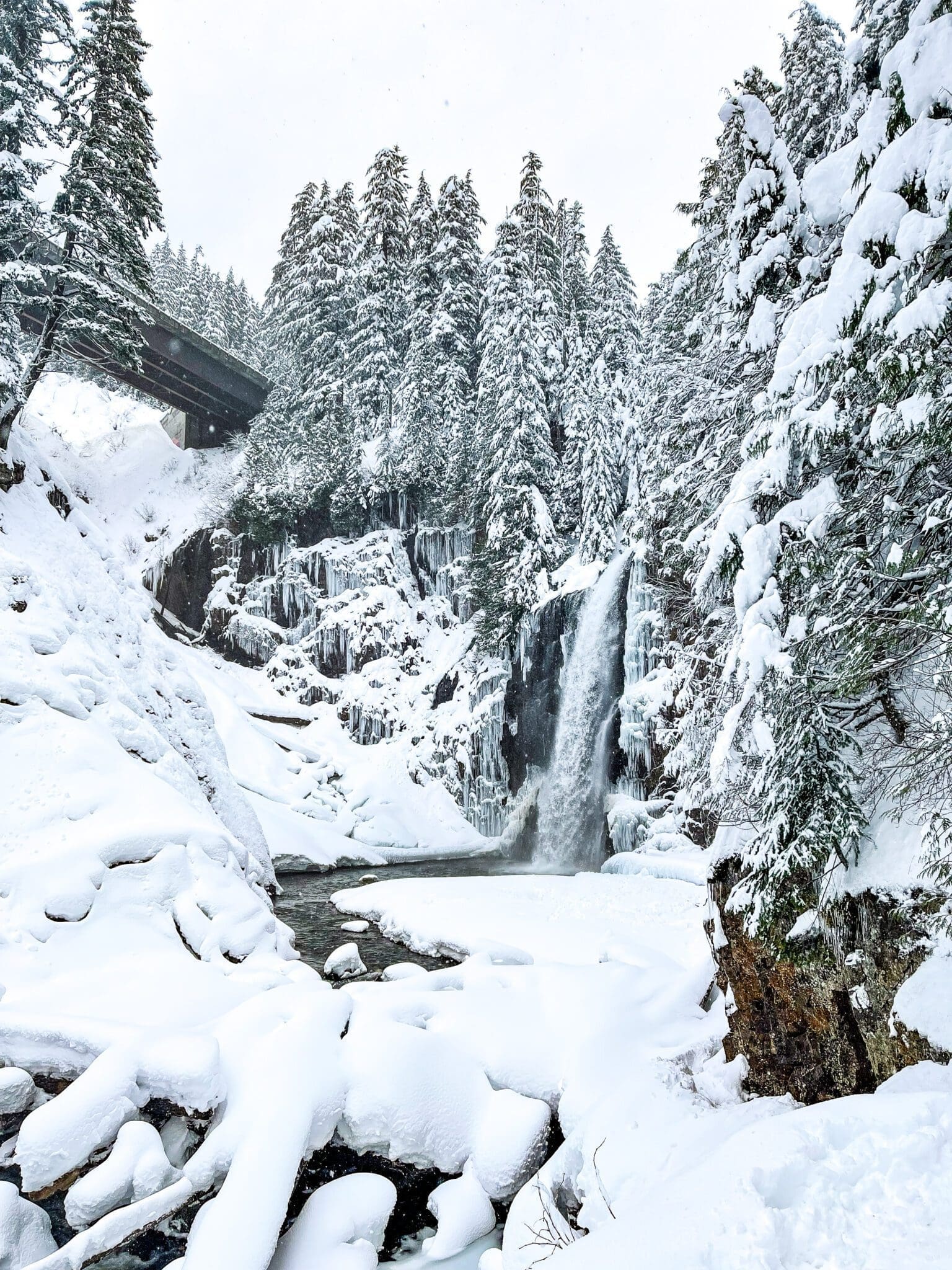
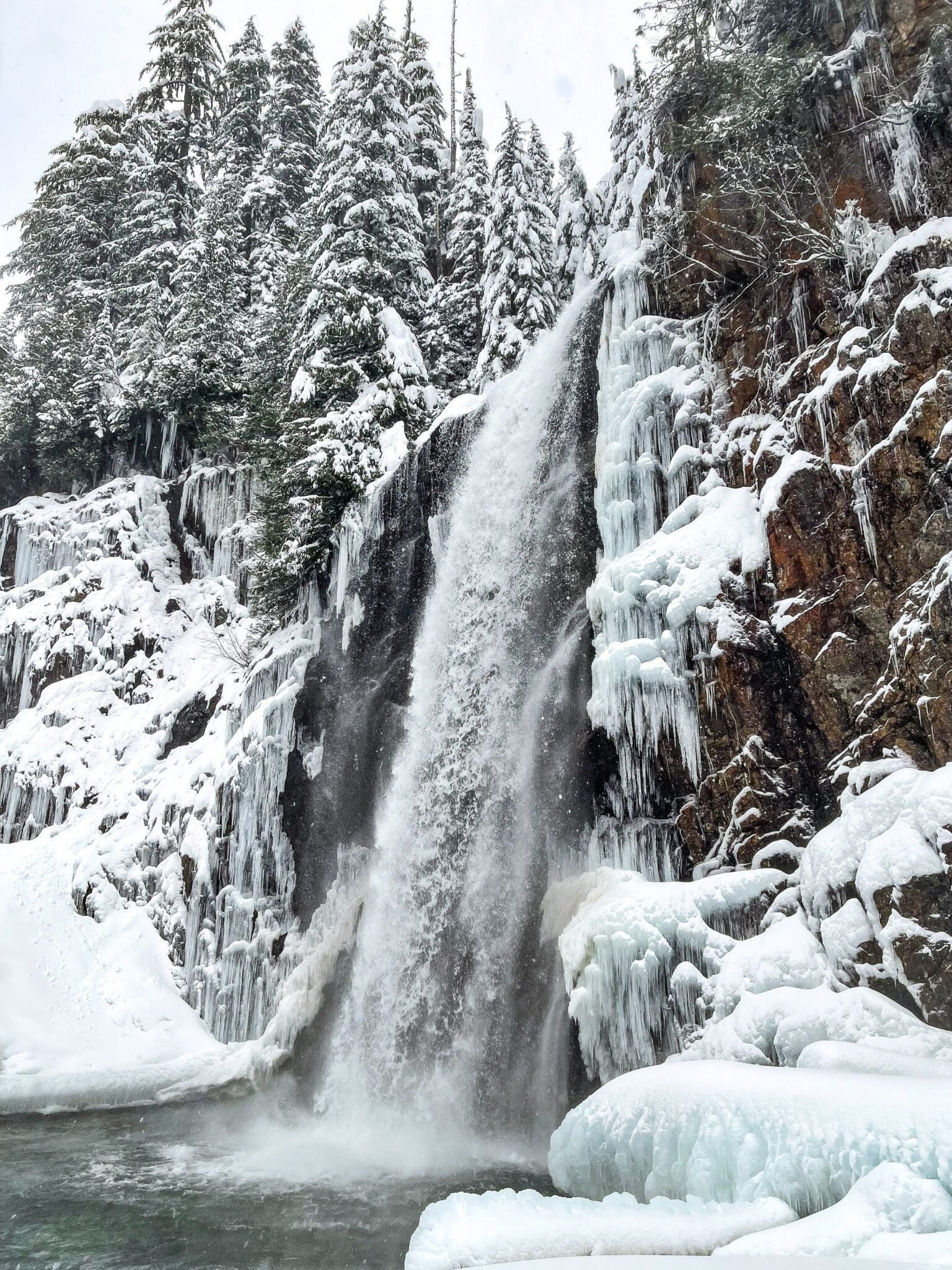

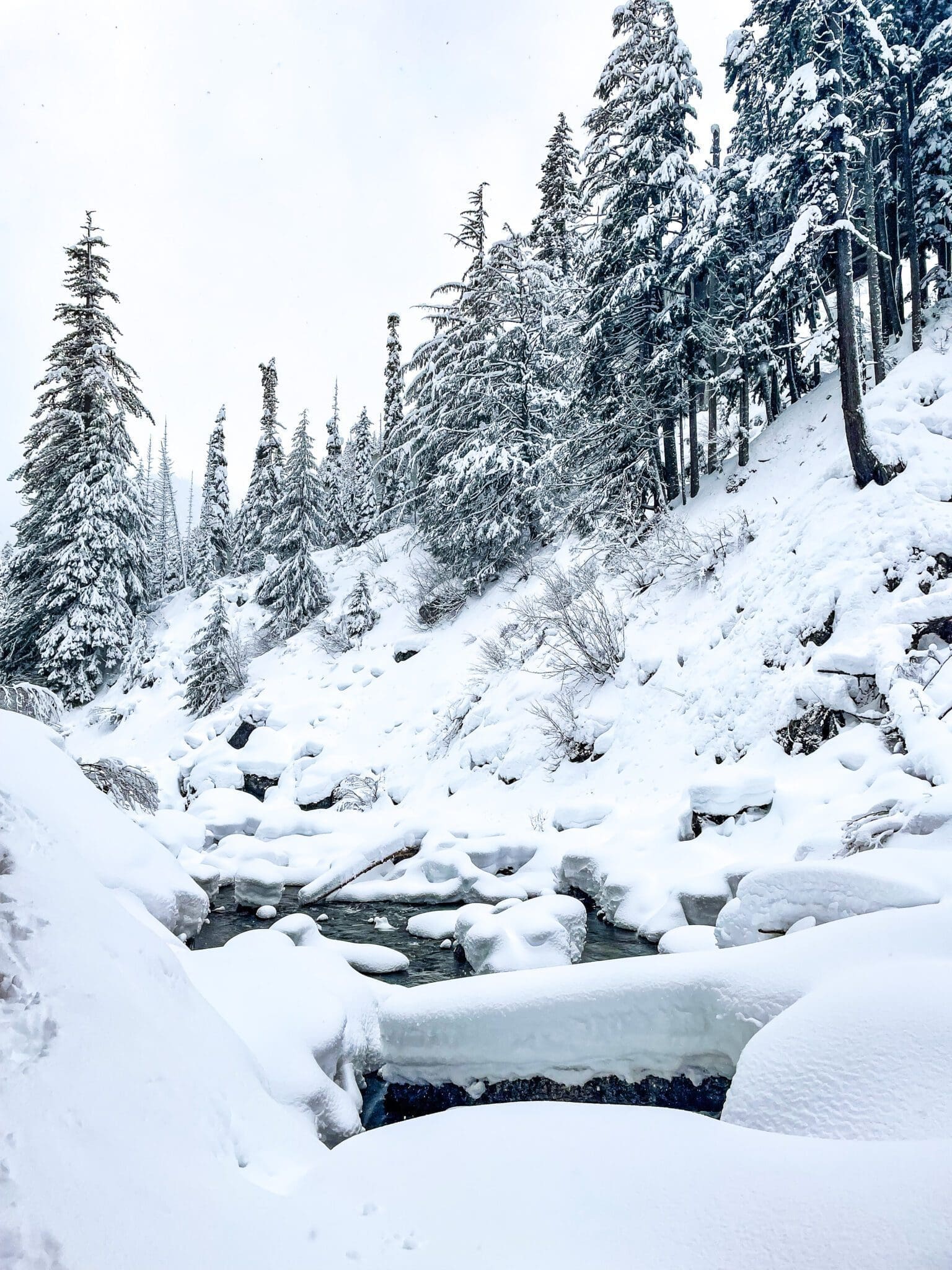
A Winter Adventure You Will Never Forget
Franklin Falls is actually comprised of three separate tiers with a total drop of 135 feet! The two upper tiers are located north of the freeway & what you experience is only the last 70 feet of the falls!
Directly next to the splash pool lies an open area that makes a great spot to take a break. However, you’ll want to stay constantly aware of your surroundings here. When the rocky faces around Franklin Falls is encrusted in ice, you may find ice climbers scaling the frozen walls. Keep your distance as you don’t want to be near falling chunks of ice! Watching fearless ice climbers hang precariously next to the powerful waterfall was reminiscent of our hikes in Banff National Park.
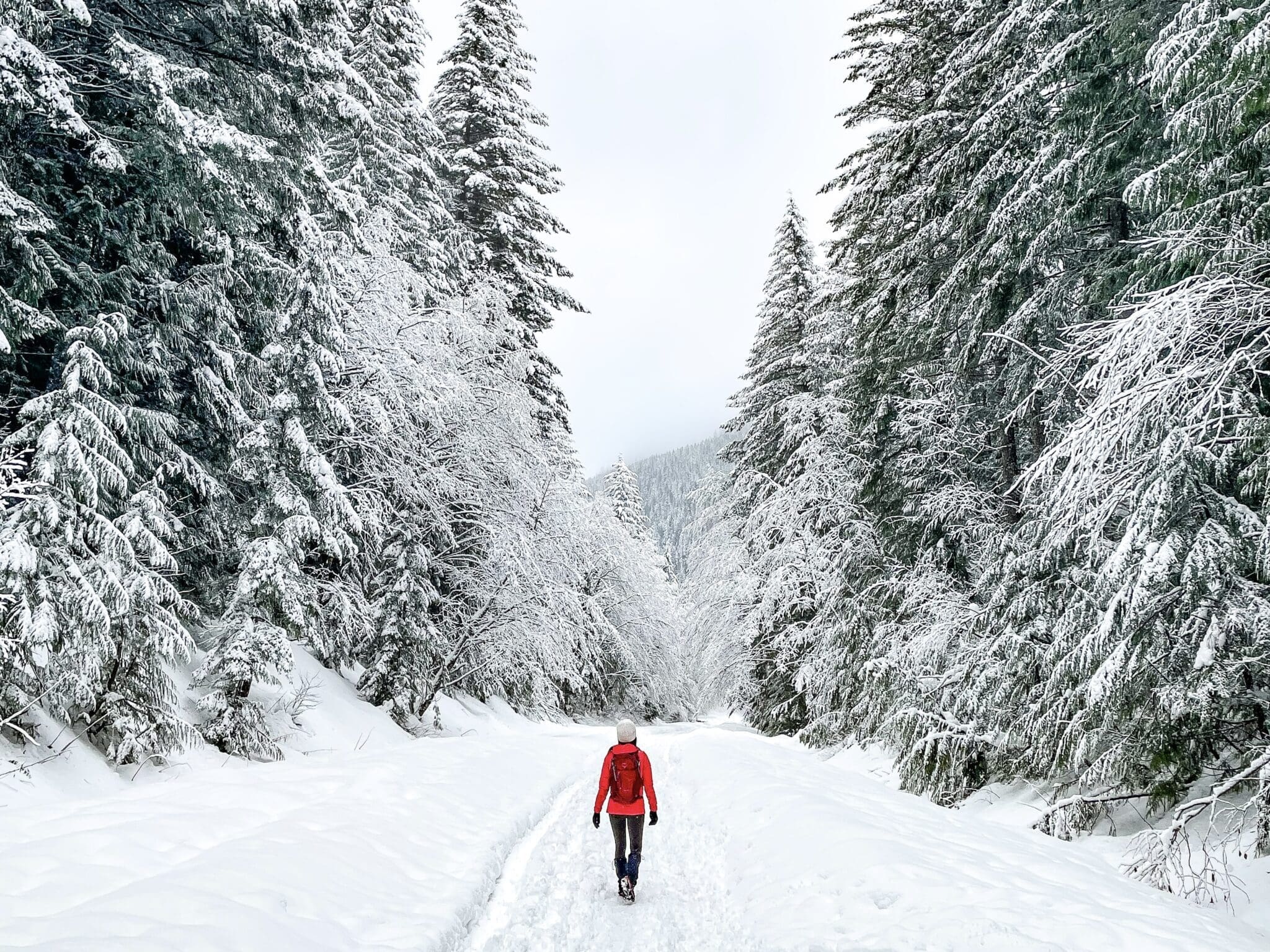
What to Pack for Hiking at Franklin Falls
As the Franklin Falls trail is mostly covered by trees & situated at a lower elevation, you won’t have to worry too much about extreme fluctuating temperatures. However, as with any winter hike in the Pacific Northwest, it is best to dress in sweat-wicking, non-cotton layers so you stay dry & warm. Sturdy, waterproof hiking boots are important for protecting your feet from the cold, snowy terrain. Since the trail is usually icy, especially heading down to the base of the falls, you will want to invest in a reliable pair of microspikes & hiking poles for extra stability. Don’t forget to pack a waterproof outer shell to keep you dry from the continuous mist & spray from the falls! Check out my blog post on winter gear recommendations for a more in-depth list of my favorite snow adventure essentials.
Winter hikes typically take more time as you navigate your way through snow & ice covered trails. As the sun sets earlier in the day, you’ll want to pack some basic hiking essentials:
- Headlamp
- Handheld GPS system
- Hand warmers
- First aid kit
- Protein-filled snacks & hot water in an insulated thermos
- Portable backpacking stove
- Hiking daypack to carry all the winter gear
- A map & fully charged phone in case of emergencies
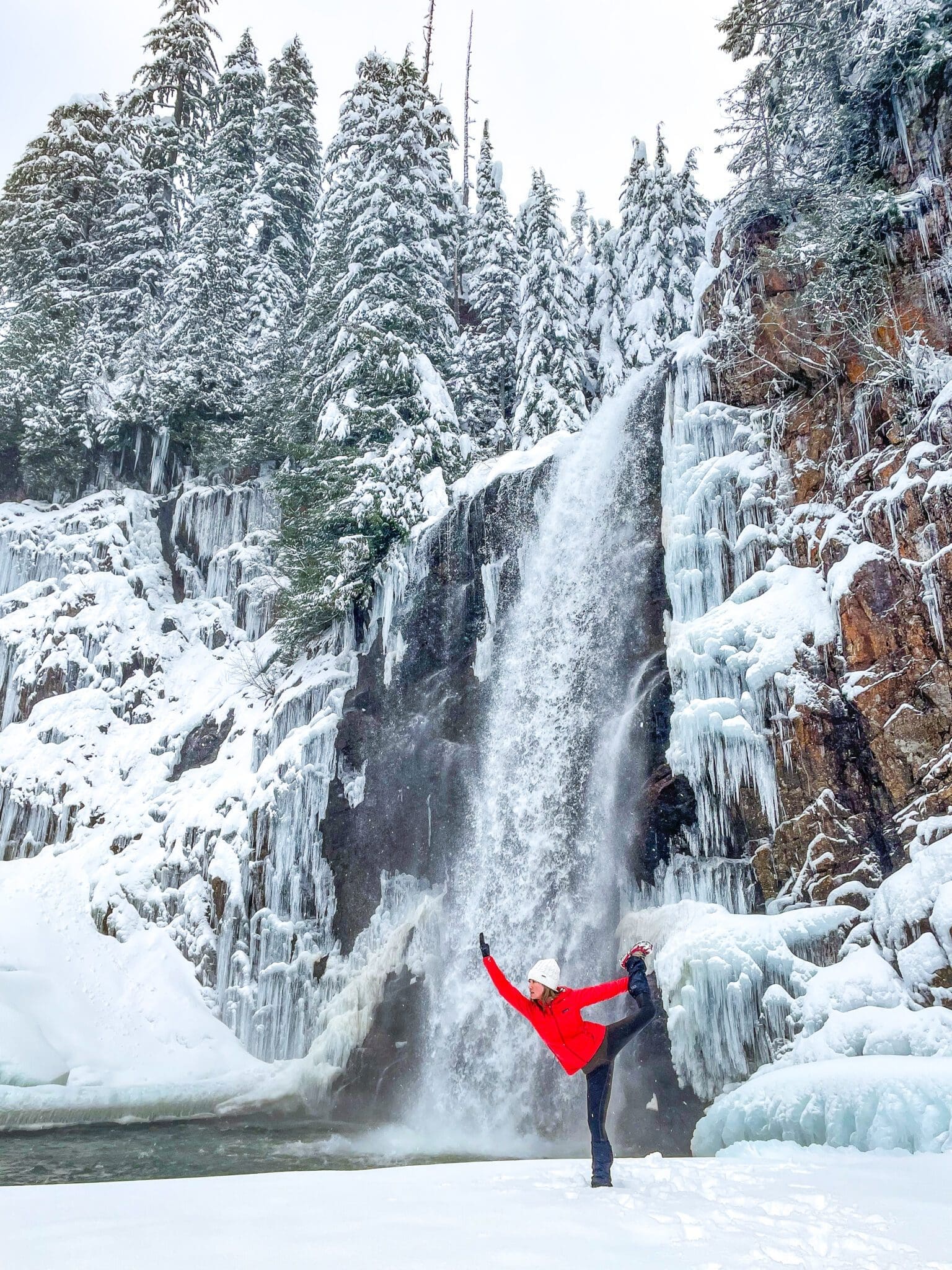
Angella’s Travel Tips
- As with any outdoor activity in the Pacific Northwest, you want to prepare for the unexpected. Before you head out, check recent trail reports & weather updates to ensure a safe & enjoyable experience.
- If you choose to visit Franklin Falls when there is snow, check the latest avalanche conditions prior to your trip. Also, use caution when entering the waterfall basin, which sits at the bottom of a steep avalanche chute.
- An alternate way to get to Franklin Falls is via the Wagon Road Trail on NF-58. For those looking for an extended snowshoe experience, this route might be more ideal as the snow is usually deeper & the area is more open for further exploration.
- In an effort to preserve the wild in our ‘wild’erness, it is important to be conscious of the effects our actions may have on public lands, the animals, & even other nature enthusiasts. The 7 Leave No Trace principles provide a framework for enjoying the outdoors while leaving the smallest footprint possible. Learn more about how you can apply the Leave No Trace principles on your next adventure to help protect the beautiful places we all love so much.


Leave a comment